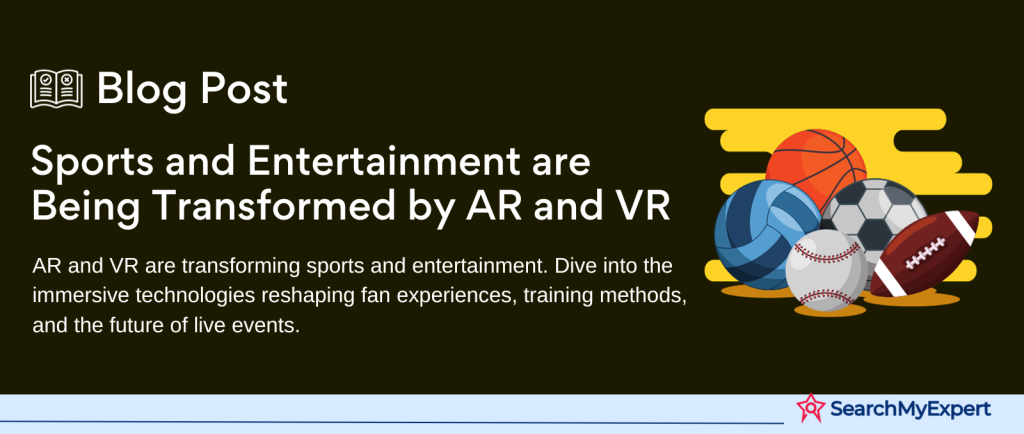AR/VR in Sports and Entertainment
Augmented Reality (AR) and Virtual Reality (VR): A Brief Overview
Augmented Reality (AR) and Virtual Reality (VR) stand as transformative technologies, each offering distinct experiences. AR integrates digital elements into the real world, enhancing our natural environment. Imagine watching a football game and seeing player stats floating next to them – that’s AR in action. On the other hand, VR immerses users in a completely digital environment, like stepping into a virtual concert where everything around you is computer-generated.
Core Differences Between AR and VR
- Perception:
AR adds to reality, VR creates its own. - Hardware:
AR can be experienced with smartphones or AR glasses, while VR requires headsets. - Interaction: AR maintains interaction with the real world, VR is entirely virtual.
Growing Adoption in Sports and Entertainment
The sports and entertainment industries are rapidly embracing AR and VR, revolutionizing how we experience games, concerts, and movies. With AR, fans get enhanced live experiences, like seeing 3D replays on a stadium’s field. VR, however, teleports fans into virtual stadiums, offering a front-row experience from their living room.
Potential Benefits
- Engagement: AR/VR offers interactive and engaging experiences.
- Accessibility: VR brings events to a global audience, regardless of physical location.
- Innovation: AR/VR drives technological advancements in broadcasting and storytelling.
Challenges to Overcome
- Cost: High investment in technology and infrastructure.
- Adoption:
Integrating AR/VR into traditional viewing habits. - Quality:
Ensuring high-quality, seamless experiences.
AR/VR technologies are set to reshape the landscape of sports and entertainment, offering immersive experiences while also posing unique challenges. Their potential is vast, with the power to redefine how we interact with and consume content in these industries.
AR/VR for Enhancing the Fan Experience
Transforming Events with AR/VR
Augmented Reality (AR) and Virtual Reality (VR) technologies are revolutionizing the fan experience in sports and entertainment. By blending the digital with the real or creating entirely immersive environments, these technologies offer unprecedented ways for fans to interact with their favorite sports and entertainment events.
360-Degree Viewing Angles
- VR Experience: Imagine being able to watch a basketball game from any angle, even from the perspective of a player. VR offers fans a 360-degree view, making them feel like they’re right in the action.
- Impact:
This creates a more immersive and engaging experience, bringing fans closer to the events they love.
Real-Time Statistics Overlays (AR)
- AR Integration: Fans in stadiums or at home can see real-time stats floating next to players or on the field. It’s like having a high-tech, interactive game program in your field of vision.
- Impact:
Enhances understanding and appreciation of the game, leading to a deeper fan engagement.
Interactive Games (AR/VR)
- Interactive Engagement:
Fans can participate in virtual games during halftime, or engage in AR-based challenges related to the event. - Impact:
Increases fan participation and entertainment value, making events more than just passive viewing experiences.
Virtual Meet-and-Greets (VR)
- Personalized Experiences:
Fans can have one-on-one interactions with their favorite athletes or performers in a virtual space. - Impact: Deepens the connection between fans and stars, adding a personal touch to the fan experience.
Impact Analysis
- Fan Engagement:
Both AR and VR significantly boost fan engagement by offering interactive and immersive experiences. - Accessibility: VR, in particular, makes events accessible to a global audience, removing physical and geographical barriers.
- Personalization: AR/VR allows for customized experiences, catering to individual preferences and enhancing the overall experience.
AR/VR for Training and Performance Optimization
Realistic Simulations and Skill Development through VR
Virtual Reality (VR) technology is a game-changer in the training regimes of athletes and performers. By simulating real-world environments and scenarios, VR offers a safe, controlled, and highly effective medium for skill development.
Realistic Training Environments
- VR Scenarios: Athletes can practice in virtual environments that mimic actual game conditions, from the roar of a crowd to weather variations.
- Skill Enhancement:
This allows for targeted skill improvement, such as a quarterback practicing passes in a virtual stadium.
Repetitive Practice without Physical Strain
- Safe Repetition: VR enables athletes to repeatedly practice specific moves or scenarios without the physical wear and tear.
- Muscle Memory:
This repetition aids in developing muscle memory, crucial for peak performance.
VR in Injury Recovery and Tactical Strategy
Injury Recovery and Rehabilitation
- Virtual Rehabilitation:
Injured athletes can engage in virtual exercises that promote recovery, without putting stress on their injuries. - Psychological Benefits: It also offers psychological benefits, maintaining a sense of involvement in their sport during recovery.
Tactical Strategy and Visualization
- Game Planning:
VR allows athletes to visualize and practice game strategies, understanding the dynamics of the game better. - Mental Rehearsal:
Athletes can mentally rehearse their responses to various scenarios, enhancing decision-making skills.
The Potential for Enhanced Performance and Reduced Injury Risk
- Optimized Training:
By providing a realistic yet controlled training environment, VR helps in refining techniques and strategies. - Injury Prevention:
The ability to train without physical strain reduces the risk of training-related injuries. - Mental Preparedness:
Athletes gain mental resilience and preparedness, crucial for high-pressure situations.
AR/VR for Content Creation and Storytelling
Revolutionizing Storytelling in Sports and Entertainment
Augmented Reality (AR) and Virtual Reality (VR) are not just tools for engagement; they are powerful storytelling mediums. In sports and entertainment, they open up new dimensions of narrative possibilities, immersing audiences in stories like never before.
Immersive Documentaries (VR)
- Deep Immersion: Viewers can step into the story, experiencing events and environments in a 360-degree landscape.
- Impact:
This deepens understanding and empathy, connecting audiences with the subject matter on a more personal level.
Interactive Narratives (AR/VR)
- Choose Your Adventure:
Users can influence the story’s direction, making decisions that change the outcome. - Impact: This interactivity leads to a more engaging and personalized viewing experience.
Blended Reality Concerts (AR)
- Enhanced Performances:
Artists can blend digital elements with live performances, creating a unique, hybrid experience. - Impact:
This fusion captivates audiences, offering them an innovative and unforgettable show.
Personalized Storylines (VR)
- Customized Experiences:
VR allows for storylines that adapt to the viewer’s preferences and reactions. - Impact:
Ensures a unique experience for each viewer, heightening their emotional connection to the content.
Analyzing the Impact
- Audience Engagement:
AR/VR elevate traditional viewing experiences, making them more interactive and immersive. - Emotional Connection:
These technologies create a stronger bond between the audience and the content, enhancing empathy and understanding. - Creative Expression:
AR/VR offer limitless possibilities for creators to experiment with new forms of storytelling.
Business Opportunities and Monetization Strategies
New Revenue Streams in AR/VR
The integration of Augmented Reality (AR) and Virtual Reality (VR) in sports and entertainment has opened up innovative revenue streams. These technologies not only enhance the user experience but also provide lucrative opportunities for monetization.
VR Ticket Sales
- Virtual Attendance:
Fans can buy tickets to attend events virtually, enjoying front-row experiences from their homes. - Impact:
This expands the audience reach, significantly increasing potential ticket sales revenue.
Sponsored AR Overlays
- Branded Content: AR overlays can feature sponsored content, like ads or branded graphics during a live event.
- Impact: This provides a new channel for advertising, leveraging the high engagement levels of AR experiences.
Virtual Advertising
- Immersive Ads:
VR platforms can host virtual advertisements, from banners in virtual stadiums to product placements in games or concerts. - Impact:
Offers a novel advertising medium, potentially more engaging and less intrusive.
Exclusive Content Access
- Premium Experiences:
Offer exclusive VR/AR content, like behind-the-scenes footage or special performances, for a fee. - Impact:
Adds a layer of exclusivity, appealing to dedicated fans willing to pay for enhanced experiences.
Analyzing the Impact
- Brand Partnerships:
The unique advertising opportunities in AR/VR attract diverse brand partnerships, opening new revenue channels. - Revenue Diversification: These technologies enable diversification of revenue streams, reducing reliance on traditional income sources.
- Market Expansion:
AR/VR transcend geographical barriers, tapping into a global market and expanding the consumer base.
AR and VR technologies are not just reshaping the fan experience in sports and entertainment; they are also creating substantial business opportunities. From virtual ticket sales to innovative advertising, these technologies offer numerous monetization strategies, driving brand partnerships, revenue diversification, and market expansion.
Ethical Considerations and Privacy Concerns
Navigating the Ethical Landscape of AR/VR
The proliferation of Augmented Reality (AR) and Virtual Reality (VR) technologies brings with it significant ethical considerations and privacy concerns. These technologies, while innovative, require a careful balance between technological advancement and ethical responsibility.
Data Collection and User Privacy
- Concerns:
AR/VR devices collect vast amounts of personal data, including biometrics, raising privacy concerns. - Responsible Handling:
Implementing robust data protection measures and transparent privacy policies is crucial.
Social Inequalities in AR/VR Access
- Digital Divide:
There is a risk of exacerbating social inequalities, as not everyone may have access to AR/VR technologies. - Bridging the Gap: Efforts should be made to make these technologies more accessible to diverse populations.
Potential for Misuse
- Abuse Risks:
The immersive nature of AR/VR can be exploited for misinformation, manipulation, or unethical advertising. - Preventive Measures:
Establishing guidelines and regulations to prevent such abuses is essential.
Responsible Development and Regulations
Ensuring User Safety
- Physical and Psychological Safety:
Developing AR/VR experiences with user well-being in mind, addressing issues like motion sickness and psychological impacts. - Safety Standards: Adhering to established safety standards and continuously updating them as the technology evolves.
Ethical Data Utilization
- Transparent Data Policies:
Clear communication about what data is collected and how it is used. - User Consent:
Ensuring that user consent is obtained for data collection and usage.
Regulatory Frameworks
- Developing Regulations:
Collaborating with regulatory bodies to establish frameworks that protect user privacy and promote ethical use of AR/VR. - Global Standards: Working towards global standards to ensure a consistent approach to ethical considerations.
AR and VR technologies advance, it is imperative to address the ethical challenges and privacy concerns they present. Responsible development, robust privacy policies, and regulatory oversight are crucial to ensuring these technologies are used in a safe, ethical, and equitable manner.
The Future of AR/VR in Sports and Entertainment
Projecting the Trajectory of AR/VR
The future of Augmented Reality (AR) and Virtual Reality (VR) in sports and entertainment industries is poised for groundbreaking advancements. As these technologies evolve, they promise to transform how we interact with and experience these domains.
Advancements in Technology
- Haptics:
Enhancing tactile feedback in VR to replicate the sensation of touch, elevating the realism of virtual experiences. - Spatial Computing:
Blending the physical and digital worlds more seamlessly, enabling more intuitive interactions in AR environments. - Brain-Computer Interfaces (BCI):
Allowing for direct neural control of AR/VR experiences, potentially revolutionizing user interaction.
Emerging Technologies Integration
- Integrating with AI and IoT:
Combining AR/VR with artificial intelligence (AI) and the Internet of Things (IoT) will create more intelligent and responsive environments. - Wearable Tech Evolution:
The development of more sophisticated wearable technologies will make AR/VR experiences more accessible and immersive.
Envisioning the Future Experiences
Hyper-Personalized Experiences
- Tailored Content:
AR/VR will offer content that adapts in real-time to individual preferences, creating deeply personalized experiences. - Dynamic Interaction:
Users will be able to influence and change their virtual environments in ways previously unimaginable.
Interactive and Emotionally Resonant Experiences
- Emotional Engagement:
Advanced biometric sensors could tailor experiences based on emotional responses, enhancing connection and immersion. - Interactive Storytelling: The evolution of interactive narratives will lead to more complex and emotionally engaging stories.
The Potential Impact
- Transformative Entertainment: The lines between reality and virtuality will blur, offering experiences that are more immersive and engaging.
- Sports Training and Viewing: Athletes will have access to more sophisticated training tools, and fans will enjoy highly immersive viewing experiences.
Conclusion
The future of AR/VR in sports and entertainment promises a blend of technological innovation and immersive, personalized experiences. The integration of emerging technologies like haptics, spatial computing, and BCIs will redefine our perception of what’s possible, paving the way for a future that’s more interactive and emotionally resonant.
Maximize your project’s potential with our AR & VR Development Service Services.
Table of Contents
Toggle






